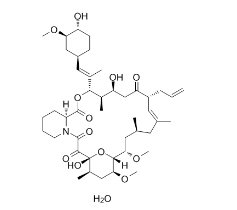All AbMole products are for research use only, cannot be used for human consumption.

In vitro: Tacrolimus (FK506) inhibits calcium-dependent events, such as IL-2 gene transcription, NO synthase activation, cell degranulation, and apoptosis. Tacrolimus also potentiates the actions of glucocorticoids and progesterone by binding to FKBPs contained within the hormone receptor complex, preventing degradation. The agent may enhance expression of the TGFβ-1 gene in a fashion analogous to that demonstrated for CsA. T cell proliferation in response to ligation of the T cell receptor is inhibited by Tacrolimus. Tacrolimus (FK506) is a powerful immunosuppressive drug widely used to prevent organ rejection after transplantation. Tacrolimus inhibit other calcineurin-dependent transcription factors including the ubiquitously expressed cAMP response element-binding protein (CREB). Tacrolimus inhibit CREB transcriptional activity at the coactivator level. The depolarization-induced transcriptional activity of the CBP C-terminus is enhanced by overexpression of calcineurin and is inhibited by Tacrolimus in a concentration-dependent manner with IC50 of 1 nM consistent with IC50 for inhibition of calcineurin.
In vivo: In the pleurisy induced by carrageenan, Tacrolimus (1 mg/kg, i.p.) and Dexamethasone (0.5 mg/kg, i.p.) administered 0.5 h before causes a significant decrease in leukocytes, neutrophils and exudation (P<0.01). Under the same conditions, Tacrolimus and Dexamethasone do not modify the blood's white or red cells (P>0.05). Tacrolimus shows a long lasting antiinflammatory effect, inhibiting leukocytes and neutrophils for up to 24 h (P<0.01), whereas the inhibition of exudation is less marked (up to 2 h) (P<0.01). These drugs caused a marked reduction in MPO activity, as well as IL-1β and TNFα levels (P<0.01), but only Tacrolimus inhibits ADA activity (P<0.01). Tacrolimus significantly inhibits cell migration induces by either bradykinin, histamine or substance P (P<0.05).
| Cell Experiment | |
|---|---|
| Cell lines | |
| Preparation method | |
| Concentrations | |
| Incubation time | |
| Animal Experiment | |
|---|---|
| Animal models | Swiss mice |
| Formulation | sterile saline (NaCl 0.9%) |
| Dosages | 0.5-1.5 mg/kg |
| Administration | i.p. |
| Molecular Weight | 822.03 |
| Formula | C44H71NO13 |
| CAS Number | 109581-93-3 |
| Solubility (25°C) | 10 mM in DMSO |
| Storage | 2-8°C, protect from light |
| Related Antibiotic Products |
|---|
| Puromycin-d3
Puromycin-d3 is the deuterium labeled Puromycin. Puromycin dihydrochloride is the dihydrochloride salt of puromycin. Puromycin is an aminoglycoside antibiotic that inhibits protein synthesis. |
| BSH-IN-1
BSH-IN-1 is a potent and covalent inhibitor of gut bacterial recombinant bile salt hydrolases (BSHs) with IC50s of 108 nM and 427 nM for B. longum BSH (Gram positive) and B. theta BSH (Gram negative), respectively. |
| AAA-10
AAA-10 is an orally active gut bacterial bile salt hydrolases (BSH) inhibitor, with IC50s of 10 nM, 80 nM against B. theta rBSH and B. longum rBSH respectively. |
| Gut restricted-7
Gut restricted-7 (GR-7) is a potent, covalent and orally active pan-bile salt hydrolase (BSH) inhibitor. Gut restricted-7 has a tissue-selective and is restricted to the gut. Gut restricted-7 decreases gut bacterial BSHs and decreases deconjugated bile acid levels in feces of mice. |
| N-Hydroxypipecolic acid
N-Hydroxypipecolic acid (1-Hydroxy-2-piperidinecarboxylic acid), a plant metabolite and a systemic acquired resistance (SAR) regulator, orchestrates SAR establishment in concert with the immune signal salicylic acid. N-Hydroxypipecolic acid accumulates systemically in the plant foliage in response to pathogen attack. N-Hydroxypipecolic acid induces SAR to bacterial and oomycete infection. |
All AbMole products are for research use only, cannot be used for human consumption or veterinary use. We do not provide products or services to individuals. Please comply with the intended use and do not use AbMole products for any other purpose.


Products are for research use only. Not for human use. We do not sell to patients.
© Copyright 2010-2024 AbMole BioScience. All Rights Reserved.
